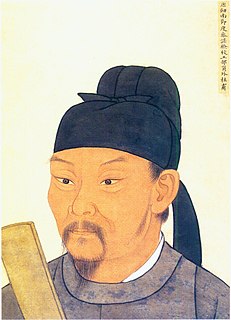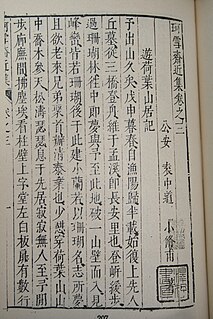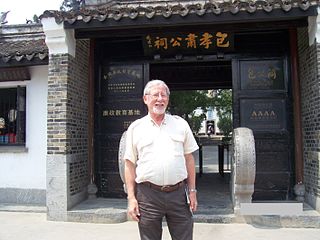The history of Chinese literature extends thousands of years, from the earliest recorded dynastic court archives to the mature vernacular fiction novels that arose during the Ming dynasty to entertain the masses of literate Chinese. The introduction of widespread woodblock printing during the Tang dynasty (618–907) and the invention of movable type printing by Bi Sheng (990–1051) during the Song dynasty (960–1279) rapidly spread written knowledge throughout China. In more modern times, the author Lu Xun (1881–1936) is considered the founder of baihua literature in China.

Classical Chinese poetry is traditional Chinese poetry written in Classical Chinese and typified by certain traditional forms, or modes; traditional genres; and connections with particular historical periods, such as the poetry of the Tang Dynasty. Its existence was documented at least as early as the publication of the Classic of Poetry. Various combinations of forms and genres exist. Many or most of these were developed by the end of the Tang Dynasty, in 907 CE.

Xu Wei was a Ming dynasty Chinese painter, poet, writer and dramatist famed for his artistic expressiveness. Revolutionary for its time, his painting style influenced and inspired countless subsequent painters, such as Bada Shanren, the Eight Eccentrics of Yangzhou, and the modern masters Wu Changshuo and Qi Baishi. Qi once exclaimed in a poem that "How I wish to be born 300 years earlier so I could grind ink and prepare paper for Green Vine " (恨不生三百年前,為青藤磨墨理紙). Xu Wei can be considered as the founder of modern painting in China. His influence continues to exert itself. Despite his posthumous recognition, Xu was manifestly mentally ill and unsuccessful in life, ending his life in poverty after the murder of his third wife and several attempts at suicide.

Du Fu was a prominent Chinese poet of the Tang dynasty. Along with Li Bai, he is frequently called the greatest of the Chinese poets. His greatest ambition was to serve his country as a successful civil servant, but he proved unable to make the necessary accommodations. His life, like the whole country, was devastated by the An Lushan Rebellion of 755, and his last 15 years were a time of almost constant unrest.

Qu Yuan was a Chinese poet and minister who lived during the Warring States period of ancient China. He is known for his patriotism and contributions to classical poetry and verses, especially through the poems of the Chu Ci anthology : a volume of poems attributed to or considered to be inspired by his verse writing. Together with the Shi Jing, the Chu Ci is one of the two greatest collections of ancient Chinese verse. He is also remembered in connection to the supposed origin of the Dragon Boat Festival.

Tao Yuanming (365?–427), also known as Tao Qian or T'ao Ch'ien (Wade-Giles), was a Chinese poet who lived during the Eastern Jin (317-420) and Liu Song (420-479) dynasties. He is considered to be one of the greatest poets of the Six dynasties period. Tao Yuanming spent most of his life in reclusion, living in a small house in the countryside, reading, drinking wine, receiving the occasional guest, and writing poems in which he often reflected on the pleasures and difficulties of life in the countryside, as well as his decision to withdraw from civil service. His simple, direct, and unmannered style was at odds with the norms for literary writing in his time. Although he was relatively well-known as a recluse poet in the Tang dynasty (618-907), it was not until the Northern Song dynasty (960-1127), when influential literati figures such as Su Shi (1037-1101) declared him a paragon of authenticity and spontaneity in poetry, that Tao Yuanming would achieve lasting literary fame. He is also regarded as the foremost representative of what would latter be known as Fields and Gardens poetry, a style of landscape poetry that found inspiration in the beauty and serenity of the natural world close at hand.

Yuan Zhen, courtesy name Weizhi (微之), was a politician of the middle Tang Dynasty, but is more known as an important Chinese writer and poet. In prose literature, Yuan Zhen is particularly known for his work Yingying's Biography, which has often been adapted for other treatments, including operatic and musical ones. In poetry, he is remembered for the inclusion of some of his poems by popular anthologies, his verses on exotic topics, and for being part of the group of "New Yuefu" poets, which often used poetry as a form of expression and protest, but one potentially subtle enough to avoid the likely repercussions of more direct criticism. The poetic circle in which Yuan Zhen was involved included Bai Juyi, among others. Politically Yuan Zhen was briefly chancellor, during the reign of Emperor Muzong.

Yuan Zhongdao was a Chinese poet, essayist, travel diarist and official was born in Kung-an in Hukuang. He shares his fame with two other brothers, Yuan Zongdao (1560–1600) and Yuan Hongdao (1568–1610); they are collectively known as the Three Yuan Brothers. The three brothers dominated the literature of the period. From a family of financial means, they printed and distributed their own works. The youngest of the brothers, Yuan Zhongdao, took years in his pursuit of a civil-service examination degree. The brothers were all openly ambivalent about social position. Yuan Zhongdao spent quantities of money on boats for his extended excursions. His brothers and their families were haunted by disease. Yuan Zhongdao's own life was a story of breakdown at the cumulative stress of family deaths and repeated failure at the civil service examination. Yuan Zhongdao's principal health problem was perhaps tuberculosis. Yuan Zhongdao would record extremes of mood within even a daily period suggesting perhaps bipolar disorder. Yuan Zhongdao was denied the complete rest he needed for such a condition due to pressing family needs. Yuan's diary, Yu chü-fei lu is his literary monument. Yuan's precarious physical and psychological condition provided the background for his preoccupation with longevity and stress avoidance. He avoided a Buddhistic vegetarian diet, perceiving a need for protein in his diet. Excessive drinking and too many wives were other perceived impediments. His travel diary is full of such detail. Yuan records an early reading of the celebrated novel Jin Ping Mei. He was likewise associated with the radical philosopher Li Zhi 李贄 (1527–1602) and his espousals of popular literature. Likewise Yuan Zhongdao had the acquaintance of the Jesuit missionary Matteo Ricci (1552–1610). In 1616 he passed the Imperial examination and obtained a succession of official posts.
Sanqu is a fixed-rhythm form of Classical Chinese poetry or "literary song". Specifically sanqu is a subtype of the qu formal type of poetry. Sanqu was a notable Chinese poetic form, possibly beginning in the Jin dynasty (1115–1234), but especially associated with the Yuan (1271–1368), Ming (1368–1644), and Qing (1644–1912) dynasties. The tonal patterns modeled on tunes drawn from folk songs or other music.
Lu Zhi was Chinese writer of the Yuan dynasty. His courtesy name was Chudao (处道) and his pen name was Shuzhai (疏斋). He was born in modern Zhuozhou, Hebei, although some accounts claim he was from modern Yongjia, Zhejiang.
Hu Zhiyu, also known as Purple Mountain Hu, was a period writer of Chinese Sanqu poetry during the Yuan Dynasty. He was from Hebei and orphaned early in life. Nonetheless he applied himself to his studies and associated with others of exceptional ability. In the 1260s he rose to the high official position of Erudite of the Court of Imperial Sacrifices. However he earned the enmity of a Muslim high minister of finance Ahmad Fanakati (?-1282). Hu was then obliged to fill lesser official positions. Others wrote of him that officials feared him while ordinary people loved him. His writings were largely poetry. He was much influenced by Song poetry with its directness and lack or ornament. His sanqu (散曲) verses were highly literate, a characteristic of the time. He was likewise gifted at a variety of literary forms, as well as a skilled calligrapher.
Wang Yun, was a writer of Chinese Sanqu poetry from Weizhou in Henan province. He was born during the Jin dynasty, but became an official under the Yuan Dynasty. Initially a local official, he was given a series of appointments in Hebei, Henan, Shantong and Fujian provinces starting in 1268. Later he was summoned to the capital where he served in the Hanlin Academy. At twenty he became the acquaintance of the renowned writer Yuan Haowen. He was a noted prose stylist in the Tang manner of unadorned directness. His poetry often depicted the downtrodden and the poor. His collected works in one-hundred fascicles is extant. A biography of Wang exists in the official history of the Yuan Dynasty (元史). Forty-one of his sanqu are extant.
Yuan Haowen also known as Yuan Yishan (遺山/遗山) or “Yuan of Yi Mountain” (1190–1257) was a poet from Xinzhou, in what is now Shanxi province, noted for his poems in the ci and the sanqu forms and for including poems in the sangluan genre of Classical Chinese poetry among his poetic works. Yuan Haowen was the outstanding literary figure of his period, in northern China, excelling at various genres of both prose and poetry: his ci poetry is said to be some of the best of the Jin period writers. Just a few of his sanqu lyrics have survived. Yuan Haowen was born in the territory of the Jurchen Jin dynasty, in what is now northern China, and which was co-existent with the Chinese Southern Song Dynasty.

Quan Tangshi, commissioned in 1705 at the direction and published under the name of the Qing dynasty Kangxi Emperor, is the largest collection of Tang poetry, containing some 49,000 lyric poems by more than twenty-two hundred poets. The Quantangshi is the major reservoir of surviving Tang Dynasty poems, from which the pre-eminent shorter anthology, Three Hundred Tang Poems, is largely drawn.
Six Dynasties poetry refers to those types or styles of poetry particularly associated with the Six Dynasties era of China. This poetry reflects one of the poetry world's more important flowerings, as well as being a unique period in Classical Chinese poetry, which, over this time period, developed a poetry with special emphasis on romantic love, gender roles, and human relationships. The Six Dynasties era is sometimes known as the "Age of Fragmentation", because China as a whole through this period lacked unification as a state, at least for any extended period of time; and, instead, many states rose and fell, often overlapping in existence with other states. Which of the various states and dynasties constituted the "6" dynasties of the Six Dynasties period varies somewhat according to which of the traditional selection criteria is chosen. The Six Dynasties era covers several somewhat overlapping main periods including all of the following: the Three Kingdoms (220–280), Jin dynasty, the Sixteen Kingdoms, and the Southern and Northern Dynasties (420–589). Sometimes, chronological discrepancies occur in regard to the turbulent political events of the time, from which these traditional historical-era designations derive, together with the somewhat different chronology of poetic developments. Thus, neither the lives of the poets nor the trends in their poetry fit gently and neatly together with these period dates. Furthermore, conversions to the Common Era dating system can create further complications. However, regardless of the chronological difficulties, major developments of poetry during the Six Dynasties include formalizing the distinction between the Jian'an era regular yuefu and the shi style poetry, further development of the fu, theoretical work on technique, and the preservation of both Six Dynasties and earlier poetry by collecting and publishing many of the pieces which survive today into various anthologies consisting all or in part of poetry.

Ming poetry refers to the poetry of or typical of the Ming dynasty (1368–1644). With over one million specimens of Ming poetry surviving today, the poetry of the Ming dynasty represents one of the major periods of Classical Chinese poetry, as well as an area of active modern academic research. Ming poetry is marked by 2 transitional phases, the transition between the Yuan dynasty which was the predecessor to the Ming, and the Qing-Ming transition which eventually resulted in the succeeding Qing dynasty. Although in politico-dynastic terms, the dynastic leadership of China is historically relatively clear-cut, the poetic periods involved encompass the lifespans and works of poets whose lives and poetic output transcend both the end of one dynasty and the initiatory period of the next.

Qing poetry refers to the poetry of or typical of the Qing dynasty (1644–1911). Classical Chinese poetry continued to be the major poetic form of the Qing dynasty, during which the debates, trends and widespread literacy of the Ming period began to flourish once again after a transitional period during which the Qing dynasty had established its dominance. Also, popular versions of Classical Chinese poetry were transmitted through Qing dynasty anthologies, such as the collections of Tang poetry known as the Quantangshi and the Three Hundred Tang Poems. The poetry of the Qing Dynasty has an ongoing and growing body of scholarly literature associated with its study. Both the poetry of the Ming dynasty and the poetry of the Qing dynasty are studied for poetry associated with Chinese opera, the developmental trends of Classical Chinese poetry and the transition to the more vernacular type of Modern Chinese poetry, as well as poetry by women in Chinese culture.

Jonathan Chaves, B.A. Brooklyn College, 1965; M.A. Columbia University, 1966; PhD Columbia University, 1971, is Professor of Chinese Language and Literature at The George Washington University in Washington, D.C. He is a translator of classic Chinese poetry.













